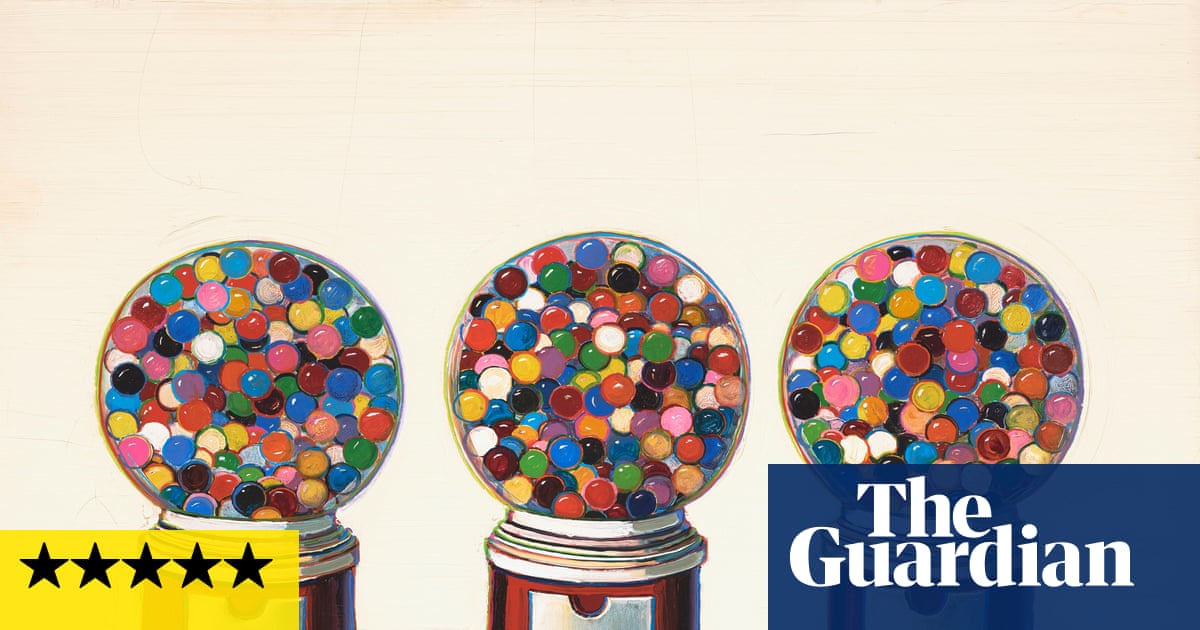You’re not allowed to lick paintings in museums, which is cruel when you’re faced with something as mouthwateringly tempting as Wayne Thiebaud’s art. The American pop pioneer dedicated his long career to cakes, sweets and gumball machines, a visual world of treats and candies laid out in American diners and on deli counters, tempting viewers to commit the ultimate crime and take a big, juicy bite.
But he didn’t just paint for the sake of getting you salivating. His work (here at the Courtauld in his first ever UK museum show) is both an ultraserious take on the material history of painting, a sort of update on the long legacy of the still life, and a deep dive into burgeoning consumerism and the capitalistic euphoria of the mass-produced, mid-century American dream.
His background offers the biggest clue to how he created his kitschy universe of pastel pastries and gloopy cherry pies. He came to art via illustration and animation, becoming an apprentice at Walt Disney Studios before going on to work as a cartoonist and motion picture animator. When you paint for a huge, mainstream audience, you get a firm grasp on directness and legibility, on how to get your ideas across immediately, like a cream pie to the face.
Delicious … Thiebaud’s Cakes, 1963. Illustration: National Gallery of Art, Washington/Wayne Thiebaud VAGA at ARS, NY and DACS
Then in the 1950s he met Elaine and Willem de Kooning and a bunch of other abstract expressionists and hey presto, you’ve got a flavour combination that works: a background in art for a big audience, and a knowledge of modern, conceptual experimentation. Delicious.
The earliest works here, from 1956, are of a butcher’s counter and a pinball machine – quintessential Thiebaud themes – but the marks are thick and grubby. It’s all dark, filthy, almost pushing towards abstraction. They’re not quite there, too muddy to get their ideas across properly.
But within five years, it all clicked. By 1961, it looks like Thiebaud. A bowl of cereal, some candied apples, a row of oozing cakes, five hotdogs, a cup of coffee – all captured in cold whites, steely greys, and the luminous yellows and pinks of lemon meringues and berry coulis. They are staggering still lifes, beautifully and thickly painted. They’re also exercises in painterly precision, in exploring the geometry of consumable goods. Pies are just triangles, cakes are cylinders. It’s very, very art historically aware, a series of riffs on Cézanne and Chardin. Look at those gumball machines, spheres within spheres, uncountable, precise, beautiful. It’s still life painting at its modern best.
A slice of American life … Four Pinball Machines, 1962. Illustration: Acquavella Galleries/Wayne Thiebaud VAGA at ARS, NY and DACS
It is also hugely conceptual. This is a slice of American life, it’s the economic boom of a world power, it’s all of the consumerism and postwar capitalism of the US expressed in lush images of delis and diners and the goods they were flogging. He is elevating the mundane side of American life to an unprecedented level of historical, aesthetic importance.
That is why pop artists loved him, and why he was included in so many pop exhibitions: it’s consumerism as subject and medium. But it’s not slick and detached like Warhol, it’s not tossed off and reproducible, it’s something more serious than that.
A visual world of treats … Delicatessen Counter, 1963. Illustration: Julia Featheringill/Wayne Thiebaud VAGA at ARS, NY and DACS
And that mixture, that conflict, is a blank slate into which you can read endless ideas. These paintings are so easy to interpret, but so beautifully done that they can be about almost anything. Want them to be about consumerism and commercialism? You got it. Want them to be about America? Easy. Geometricism, art history, the physical nature of paint? Go for it, it’s all of these things and none of them.
The show only goes up to 1969, which means you’re somehow left hungry for more of his sickly sweet and waist-bulgingly calorific painting. That’s what Thiebaud does, he makes gluttons of us all.
Wayne Thiebaud: American Still Life is at the Courtauld Gallery, London, from 10 October to 18 January
